Pimsleur

Summary
Pimsleur is one of the most popular and longest-standing resources out there for learning a foreign language. Its courses place a strong emphasis on aural and verbal communication skills, paying less attention to grammar explanations and reading or writing skills. There are over 50 language courses available with Pimsleur, and the bulk of the material is taught with audio lessons.
The platform is extremely well designed and easy to use. The content seems to be of high quality at all levels.
Timely repetition and active practice work well, and lessons build on each other nicely, but the “intermediate fluency in 30 days” claim may be a stretch.
The subscription option provides good value for some, but there may be more efficient ways to learn some languages.
I Like
- The lessons are structured well and are an appropriate length.
- There are both male and female native speakers.
- Lessons build on each other nicely.
- The platform is easy to navigate and visually appealing.
I Don’t Like
- There’s very little visual content.
- Lesson speed isn’t customizable.
Price
Subscriptions of either $14.95/month or $19.95/month are available for courses with at least 60 lessons. Prices otherwise range from around $20 to over $500. All purchases come with a 7-day free trial.
What is Pimsleur?
Frankly, it’s an institution. The name comes from linguist Paul Pimsleur, author of many books on language acquisition and applied linguistics, and developer of what is now known as the Pimsleur Method.
Dr. Pimsleur wrote the first Pimsleur Language Program in 1963, and the courses were first available on cassette tapes and books before becoming available digitally.
Given that the lessons are largely audio-based, the Pimsleur courses are often advertised as a convenient way to study a language while completing chores, cooking, driving, or doing anything that doesn’t require all of your attention.
The courses consist of core 30-minute audio lessons as well as some extra practice activities that touch on a variety of skills, but there’s a heavy emphasis on speaking and listening skills.
The Pimsleur Method: An Overview
There are four main pillars in The Pimsleur Method. The first, Graduated Interval Recall, works just like a type of spaced repetition system (SRS). It’s an effective method for committing new terms to long-term memory in an efficient manner.
Where it differs from other SRS platforms like Anki or Memrise is that the intervals in which you review words are time based rather than performance based. The method seems to work well in conjunction with the active role listeners take in the audio courses.
The second is what they call the Principle of Anticipation, which means that there are frequent pauses in the audio lessons that allow you to work through scenarios on your own before hearing the correct response. This makes active participation an integral part of the Pimsleur Method.
The final two mainstays of the method are Core Vocabulary and Organic Learning. These concepts essentially mean that learners are only exposed to the most necessary vocabulary words and that learning happens in the context of relatable, usable conversations.
How We Did this Review
With the aim of achieving a more comprehensive perspective for this review, I teamed up with All Language Resource’s very own web manager, Hunter.
Hunter:
“I’ve always considered myself an aural learner so I was really looking forward to trying Pimsleur. It seemed like something I would really benefit from. I tried the beginning levels of Spanish to see what I could learn and the advanced levels of French to see how far the course could take someone.”
Brian:
“I was excited to try out the Pimsleur course to see if the audio lessons worked for me. I don’t consider myself to be much of an aural learner and typically gravitate toward resources with an interactive or visual bent. I tried the beginning levels of the German and Japanese courses as well as the advanced Spanish lessons to see what I could learn.”
Quick Opinions
I think it’s safe to say that, overall, Hunter and I are both fans of Pimsleur. We both agree that it’s something we would recommend to beginners that are interested in an aurally focused course. Generally, we found it to have high-quality audio, well-structured lessons, and a nice design.
My biggest gripe with the platform was the lack of visual content, which is hard for me to deal with. Meanwhile, Hunter found himself wishing that lessons would progress at a faster pace, especially at the lower levels.
Here are our individual overall ratings of the platform:
Hunter: 3.8/5 Stars
Brian: 4.2/5 Stars
Overall combined rating: 4/5 Stars
Try a free 7-day trial of Pimsleur
First Impressions
It’s hard to deny the slick, premium feel that permeates the Pimsleur platform. Both Hunter and I came away with similar things to say about our initial impressions of the resource.
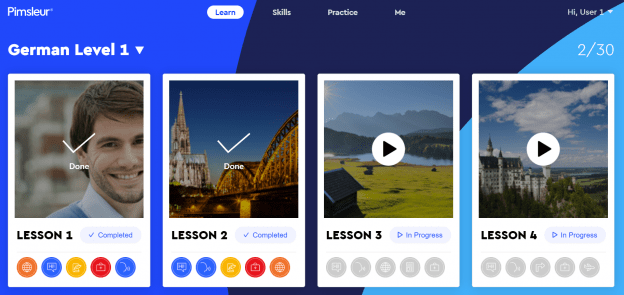
We agree that the design quality inspires confidence in the efficacy of the resource and that it made us excited to use it. The audio quality is also immediately recognizable as excellent.
I found myself wishing very early on that there was a transcript to follow along with, as I’m prone to spacing out when there’s only audio to focus on. Hunter seconded this wish, even though he identifies as an aural learner.
A Pimsleur Course Overview
Core Audio Lessons
These 30-minute lessons are where most of the learning happens in a Pimsleur course, and we think they’re done really well.
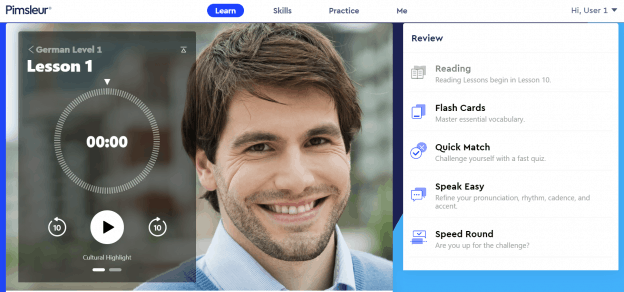
This is what you’ll spend most of your time doing with Pimsleur: listening to audio lessons. The Pimsleur Method strongly suggests doing one per day, and this method works nicely if it fits into your schedule. Anyone with a commute that’s longer than 30 minutes, for example, could find that these lessons are easy to add to the routine.
Note, though, that these lessons can require quite a bit of concentration. Passive, distracted listening isn’t going to work very well.
The audio lessons are very interactive, meaning you’ll get to participate in the conversation. The narrator offers some explanations and guides the lesson, and you’ll get plenty of opportunities to practice your pronunciation with male and female native speakers.
The lessons also build on each other exceptionally well, especially at the beginner level. Each lesson provides sufficient review for the previous lesson, and you’re constantly building upon what you’ve already learned.
Explanations
Hunter mentioned that he thought the explanations in the audio lessons were exceptionally well done, and I have to agree — the location of explanations within lessons feels very intuitive. In our experience, you aren’t kept in the dark for very long at any point — an explanation seems to appear just as you start wishing for one.
It could be nice, we both agree, if there was something more in the way of grammar explanations. This isn’t to suggest lengthy explanations or taking away from the practical focus of the lessons, just that a little bit of grammar support for those that prefer to think things through would be helpful.
Practice Activities
These activities certainly aren’t the main show in a Pimsleur course. They’re simple, quick, and not required.
I found myself enjoying the opportunity to actually see the language I was learning and thought that, though basic, the exercises were engaging enough to keep me interested.
I also appreciate the fact that you can get some comprehensive review this way. You can select from as many of your completed lessons as you like when choosing what material to practice.
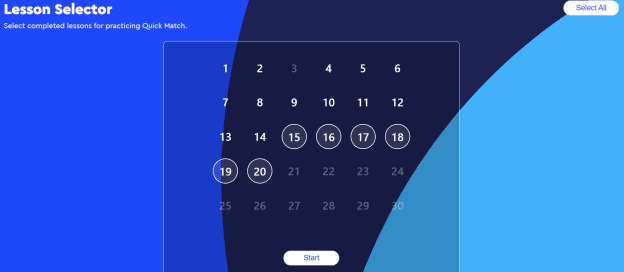
It’s nice to be able to review material that you might not have seen for a while instead of only one lesson at a time.
It might be nice if the platform kept track of which words you repeatedly had trouble with, but the interval recall works well at providing timely review in the audio lessons.
Hunter wasn’t a fan of these activities. As someone that prefers audio lessons, he says he found himself wanting to skip them altogether.
Maybe it’s good that activities using the written form are available for people like me who prefer visual material, but they won’t really get in the way of a learner that’s happy sticking to the audio.
Flashcards
This is the first practice activity you’ll likely engage with, and it’s also the most basic.
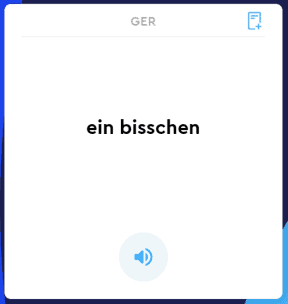
Practice is really simple with these flashcards — you can choose whether you’d like to translate from your target or source language, and then you’ll be shown the audio and written form of some material from the current lesson. Don’t expect any extra information like noun gender, verb tense, or word type!
After viewing and listening to the word or phase and then clicking to reveal the translation, you’ll either select “Skip” or “Got it.”
Selecting “Skip,” presumably because you weren’t able to come up with the correct translation, means you’ll see the flashcard repeated at the end of the set.
Quick Match
Despite what the name and description seem to insinuate, there isn’t a timed element to this activity.

Instead, it’s pretty much a straightforward multiple-choice quiz: choose the correct translation from a list of four.
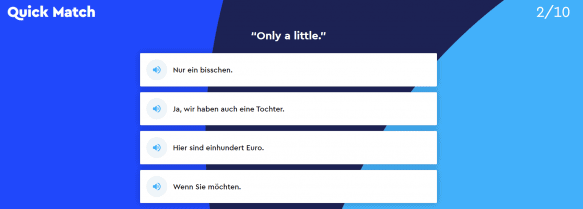
Speak Easy
This activity is actually the closest thing to a transcript of the audio lesson. You’ll get to listen to and see the phrases in a conversation, listening and repeating as you wish.
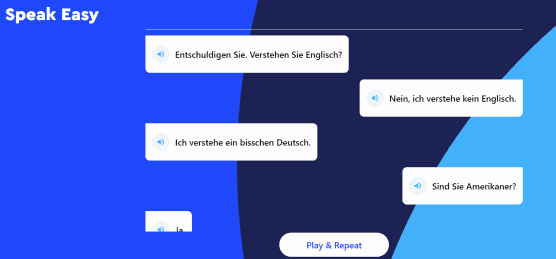
You can listen to each phrase individually or let the entire conversation play through.
Speed Round
Unlike Quick Match, this activity is aptly named. Words and phrases make their way down the screen in Space Invaders fashion (for the uninitiated), and you’re tasked with selecting the correct translation before they reach the bottom.
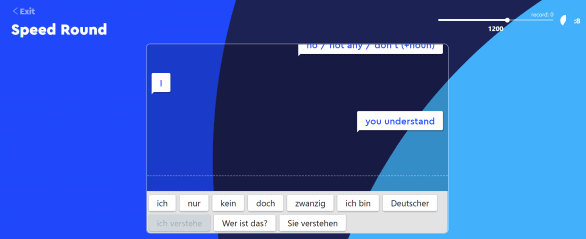
There are some satisfying sounds that accompany correct answers, and you can watch the points bar fill up to try and set a new record, but it’s mildly fun at best in my opinion.
Reading Lessons
The reading lessons in Pimsleur start off teaching how to read phonetically. After the sound system has been covered, you begin to see reading comprehension exercises in the course.
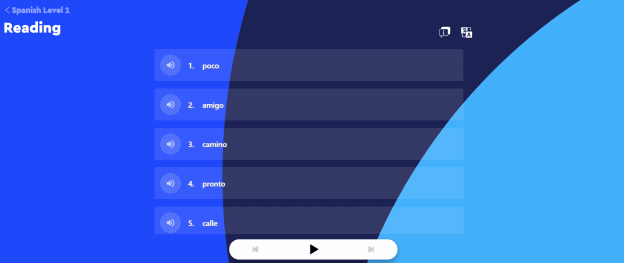
The image above shows the first reading lesson in the Spanish Level 1 course. Your job is to read the word aloud and then listen to a native speaker to check your pronunciation.
As you progress, the utterances become longer and more complex. You can view translations at any time by selecting the icon in the upper-right corner.
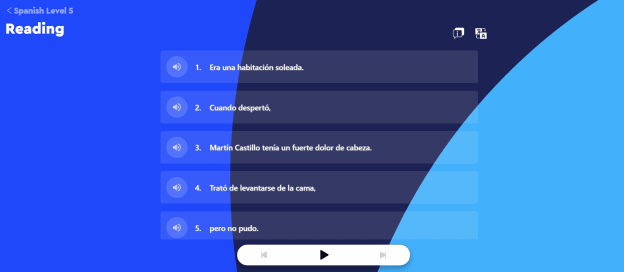
This system works fine for Latin alphabets, but it requires some tweaking for Asian languages like Japanese.
For non-Latin alphabets, you’ll have to spend more time learning the individual characters that make up the writing system. In the Japanese course, you’ll cover hiragana in Level 1, katakana in Level 2, and begin with kanji in Level 3.
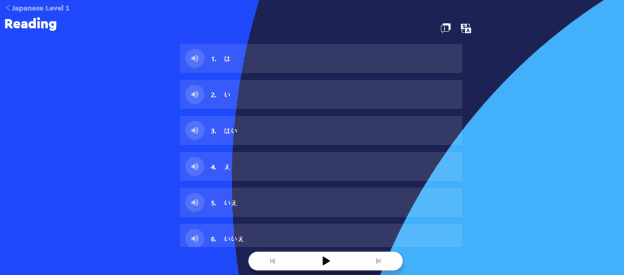
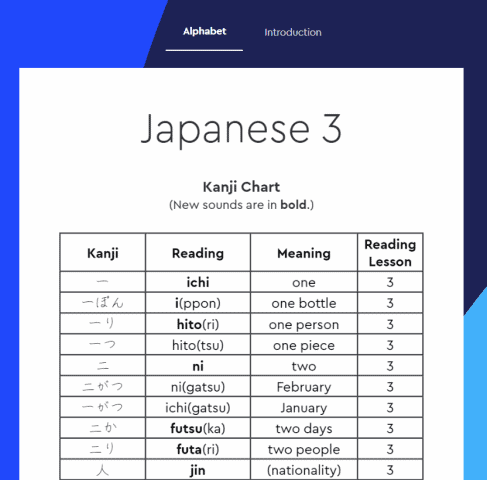
I think I would’ve liked to see some SRS-style practice for learning Japanese kana, though it’s easy enough to get this kind of practice for free with user-created materials on either Anki or Memrise.
It would probably be best to incorporate some kind of complementary study resource if you want to learn to read Japanese relatively quickly.
You will allegedly be able to read at the same level you can speak after 30 lessons, but the aural and reading lessons are delivered at different speeds.
I see the value in teaching pronunciation separately from reading — especially for languages without highly phonetic writing systems. However, I think I prefer a more traditional method that presents words and their written form in tandem as you’re exposed to them.
I think the big takeaway here is that Pimsleur courses, historically audio-exclusive, still aren’t designed to provide comprehensive reading and writing practice. It’s nice that they provide some practice and exposure that’s certainly helpful in some way, but Pimsleur is best at teaching listening and speaking skills.
Some courses offer Culture Notes instead of reading lessons. In each lesson if you swipe the main image you will find the cultural notes.
Pricing
Pimsleur pricing is complicated; your location and the language you’re studying will both influence how much it will cost. There is a 7-day free trial with all purchases.
It isn’t clear which countries have access to the subscription option, but if you live outside of the US, Canada, Australia or the UK, you’ll have to access it through the Pimsleur app.

Subscriptions are available for all languages that have at least 60 lessons, and the recurring price depends on how much content is available. Here are two examples:
Castilian Spanish (2 levels, 60 lessons): $14.95/month
Latin American Spanish (5 levels, 150 lessons): $19.95/month or $149.95/year
In the above examples, the Castilian Spanish course doesn’t offer the practice activities that come in addition to the audio and reading lessons. This appears to be true for all $14.95/month subscriptions.
There are also one-time purchase options that are available for all languages. They range from around $20 for five-lesson bundles to over $500 for all of the lessons in a popular language like French.
In addition to the above variations, what you’ll pay depends on where you live. For a Castilian Spanish subscription, for example, you’ll pay $14.95/month if you’re in the USA, $18.95/month in the UK, and $16.95/month in Australia. These prices are all in USD.
Alternatives to pimsleur
Pimsleur is one of the bigger players when it comes to language-learning resources, but it’s certainly not your only option.
olly (I will teach you a language)

Olly Richards, the creator of I Will Teach You A Language, has written a series of books for beginner and intermediate learners to improve their conversation skills in several languages. He also has a Short Storiesseries.
Most of the languages use the most common words in your target language, with natural phrases that you would overhear locals using while conversing amongst each other. In the short story lessons, the plot follows the same characters and adventures, with some adjustments for cultural differences.
Rocket languages

The things that Rocket Languages do well are developing a logical and thorough curriculum and providing ample practice opportunity. Reading, writing, and listening practice with native-speaker audio will get you a bunch of exposure to the language. Their program is extremely thorough and has lots of practice to ingrain memorization of the langauge.
ITALKI

italki is the most flexible and affordable place to find a tutor for the language you’re learning. They have a huge number of teachers offering classes to students of over 100 different languages. As a learner, you’ll be able to find a tutor that best fits your learning style, schedule, and personality. Teachers are able to set their own prices and make their own schedule. Check our our full review here!
Babbel
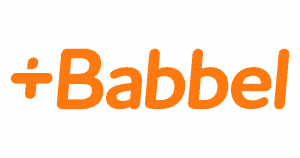
Babbel is similar to Pimsleur in that it’s a major player in the language-learning sphere and that it caters to learners looking for a comprehensive resource.
It differs by providing more of an early emphasis on learning the written language, which some learners may prefer. This makes it potentially more appealing to visual learners or those that are interested in developing their reading and writing skills in tandem with their verbal and aural skills.
Babbel provides listening and speaking practice in conversation exercises that use speech recognition technology to give feedback on pronunciation. This is our full review of Babbel.
FLUENTU

FluentU is a language-learning platform that uses real-world videos and interactive subtitles to create an immersive learning experience. The videos take on a variety of forms, including commercials, music videos, interviews, and more. Accompanying quizzes give users the chance to practice language used in videos.
FluentU offers videos in nine different languages and is available for iOS, Android, and on the web. Most of its content is beyond the beginner level, but it has videos for learners at all levels. Check our full review here!
Final Thoughts
Pimsleur has been around for decades, and that’s no fluke. It’s a quality resource, and it teaches languages well. The fact that it all started with a renowned linguist and author on language acquisition is no side-note, either.
Compliments aside, I don’t think Pimsleur is the right choice for every learner. I wouldn’t even feel comfortable saying it was the right choice for most learners.
Between Hunter and I, the platform seems better suited to his learning style. My preference for visual content means I probably wouldn’t purchase access to a Pimsleur course unless it was for a language without many alternatives.
Even though Hunter prefers audio lessons, he still probably wouldn’t become a subscriber to Pimsleur unless he was an absolute beginner of the language he was learning. He felt that the material sometimes progressed too slowly.
We all have different learning styles. Pimsleur may cater to your learning preferences better than they do to ours. For a different point of view, check out this detailed Pimsleur Review to help you decide.
MOST RECOMMEND RESOURCES BY LANGUAGE
ChineseSpanishGermanFrenchPortugueseKoreanRussianJapaneseArabic


Do you have an idea of how much vocab is taught in all 5 levels of the Pimsleur Mandarin course? Also, is the accent a neutral accent or distinctly Beijing? Any help would be much appreciated. Love the site btw!
I think it could be alright if you jumped into one of the higher levels, but not certain how it would align with your own level. They do have a trial for the subscription, so you could try it out and see if it fits. Glossika or Speechling could be worth checking out as well if you’re looking for a resource that really forces you to speak more.
I’m curious whether Pimsleur would be helpful for a false beginner or intermediate learner trying to get over the plateau and start speaking more. The only sample lesson they have on their site is clearly for students starting from zero. Any advice for me?
I love the premium app vs. the basic app. I believe without the extra practice , like seeing the language and spelling, I wouldn’t learn as well. I am a visual and audio learner and I need both.
Can’t wait to move on to the next level.
Wow, that’s really funny. I thought it was the perfect description of their app 🙂
LOL that review in your article is mine. What a small world.
I have discovered the Quick Match section is helpful for reviewing old lessons. Instead of re-listening to the whole lesson, I can pull up Quick Match, listen to the English without looking at the answers, try to translate it before I look, then look for my answer and see how I did and play it to check my pronunciation. There are 32 sentences that cover the material from that lesson pretty well. I just finished the five Spanish levels and I am very happy with the program! Spanish had reading exercises for the later lessons, like maybe after lesson 10 of each level. They were helpful. In the later levels they started telling a story, which I enjoyed, but the last lesson of level 5 ended on a cliffhanger! I want the rest of the story. ? My one complaint about the subscription is that now that I’m finished with the Spanish I have to actually cancel the subscription and re-subscribe to do a different language. That seems strange and inconvenient. I even called customer service to verify that I really had to do that and I do.
I don’t think you do but am not completely certain on that.
Do you need an American address to sign up?
I didn’t realize this at the time but I think the free trial only works for people connecting from the USA. I live in China and use a VPN to connect. I checked a few different countries and it seems like USA is the only one that will link to the free trial page.
The subscription link for a 7-day trial is not working for me 🙁